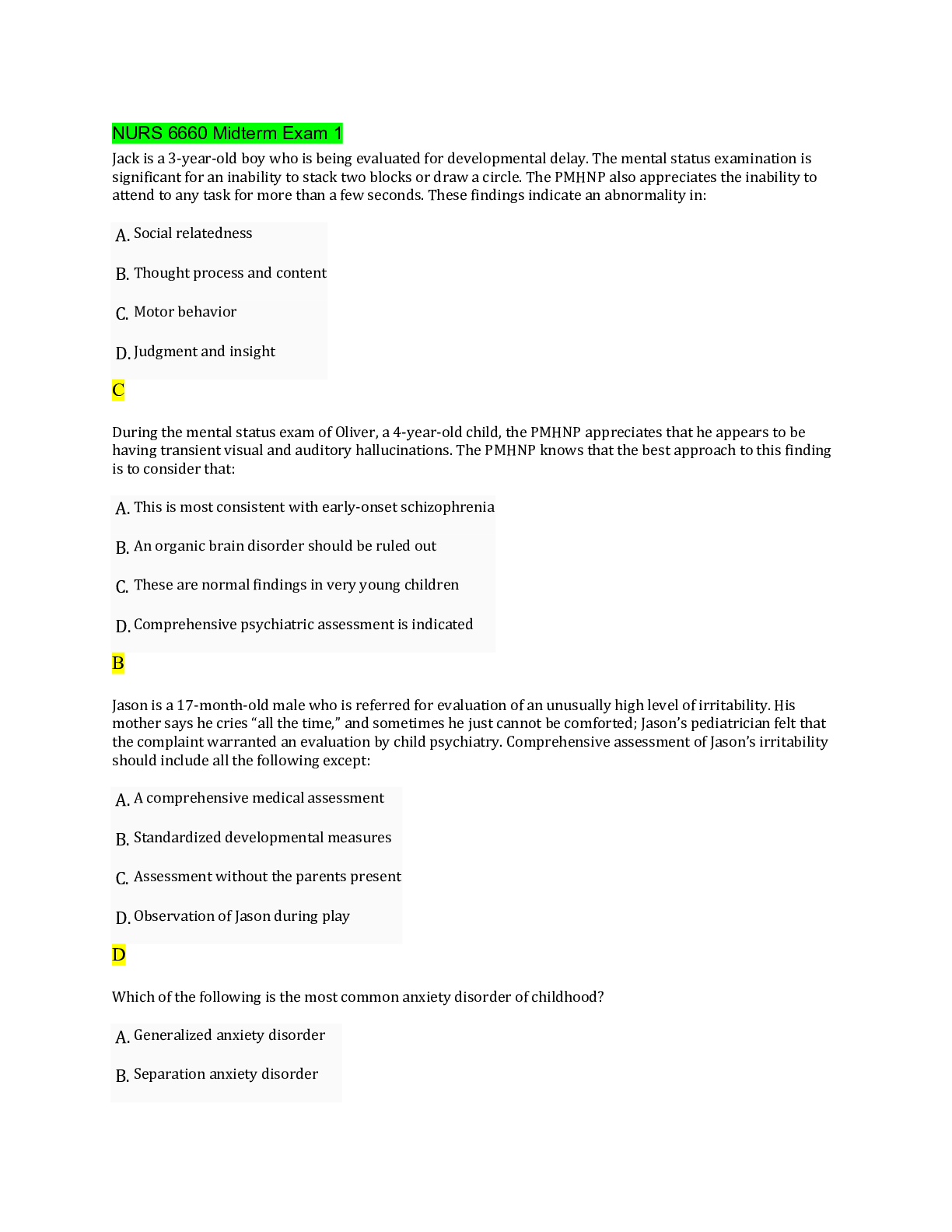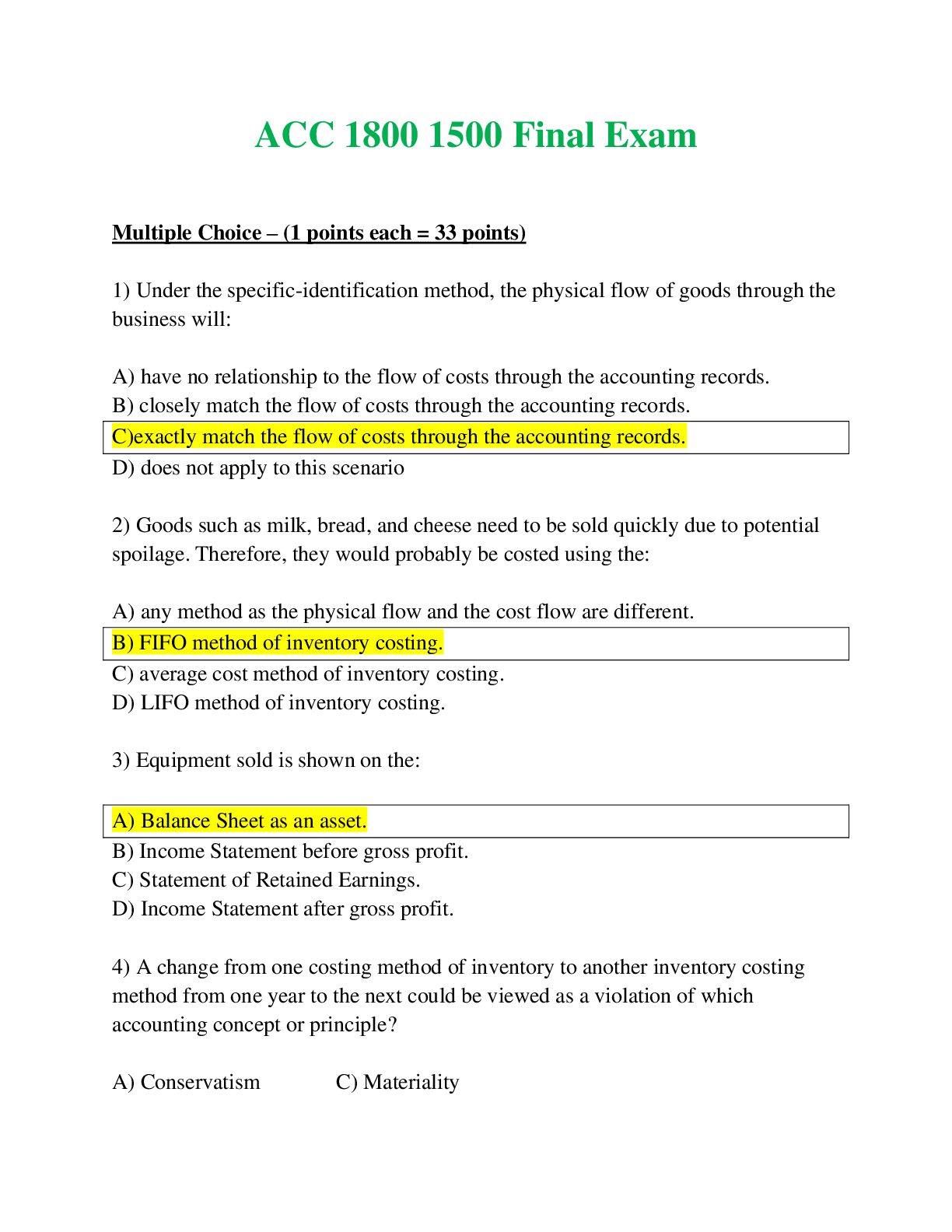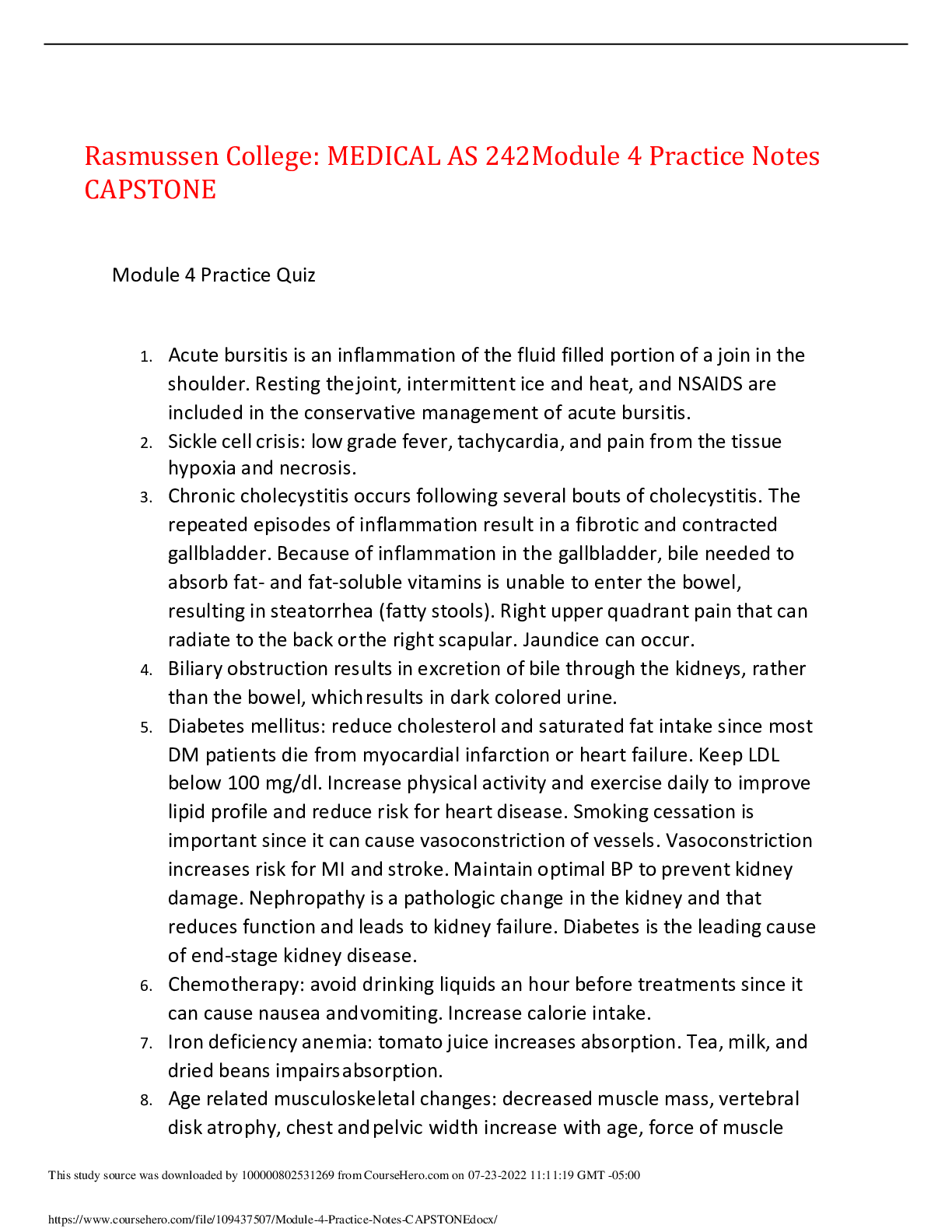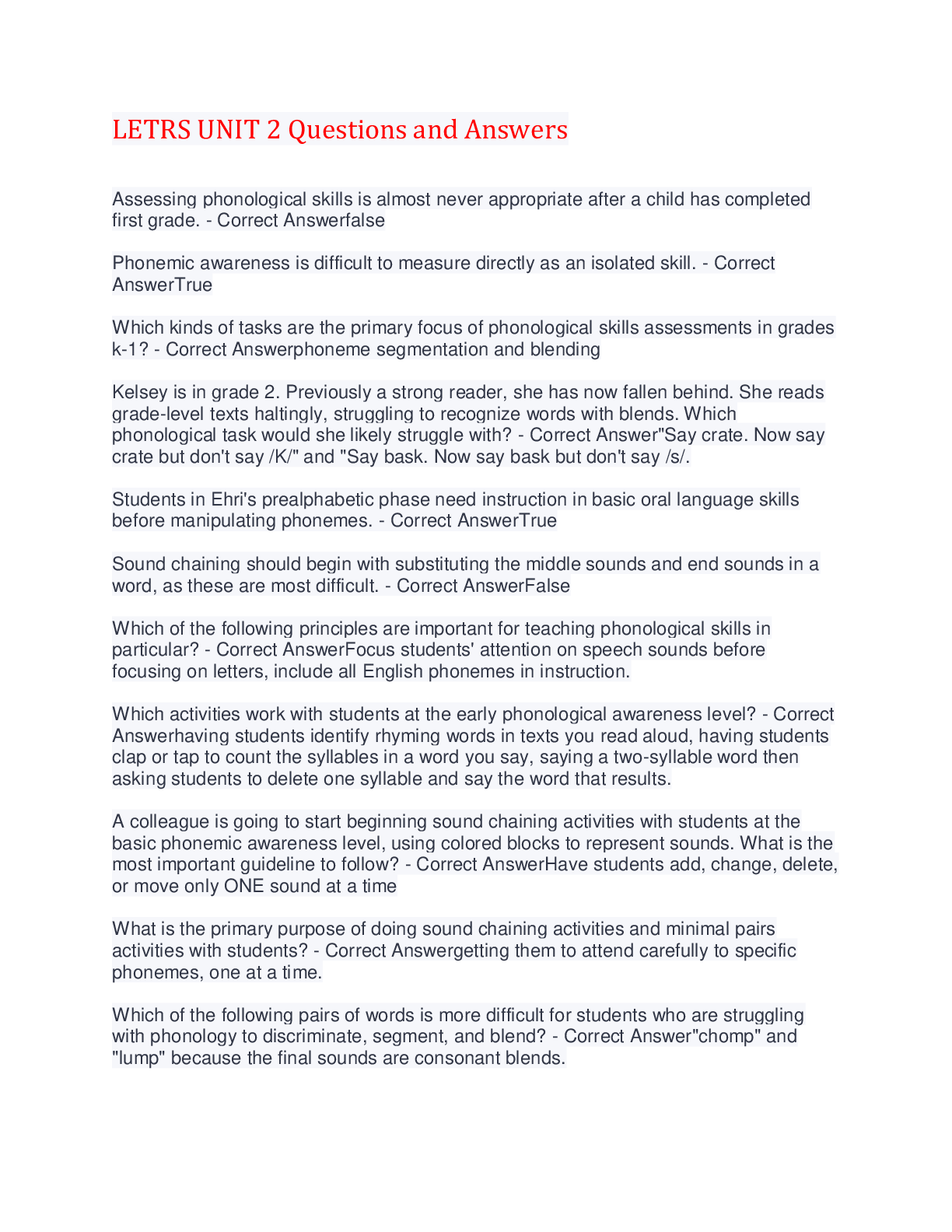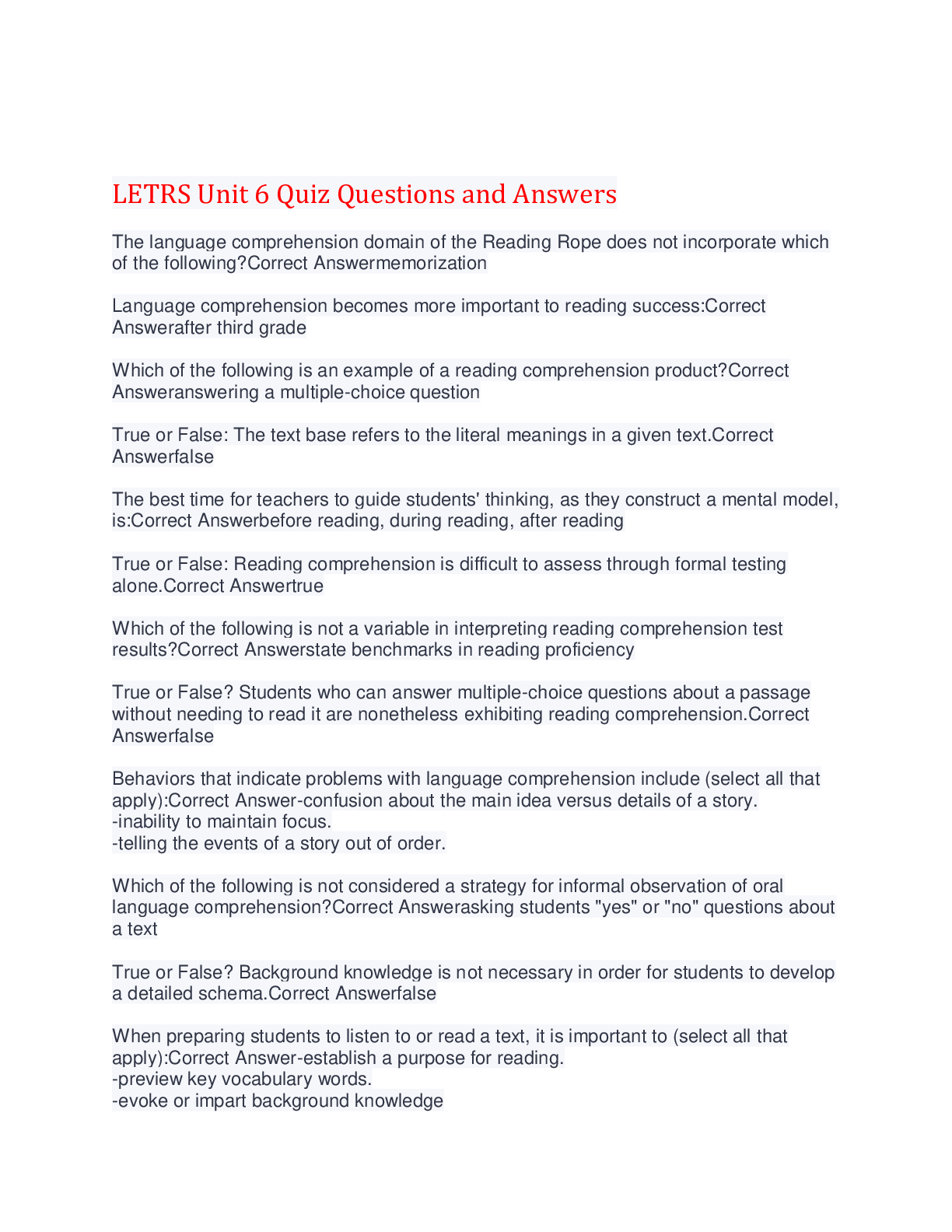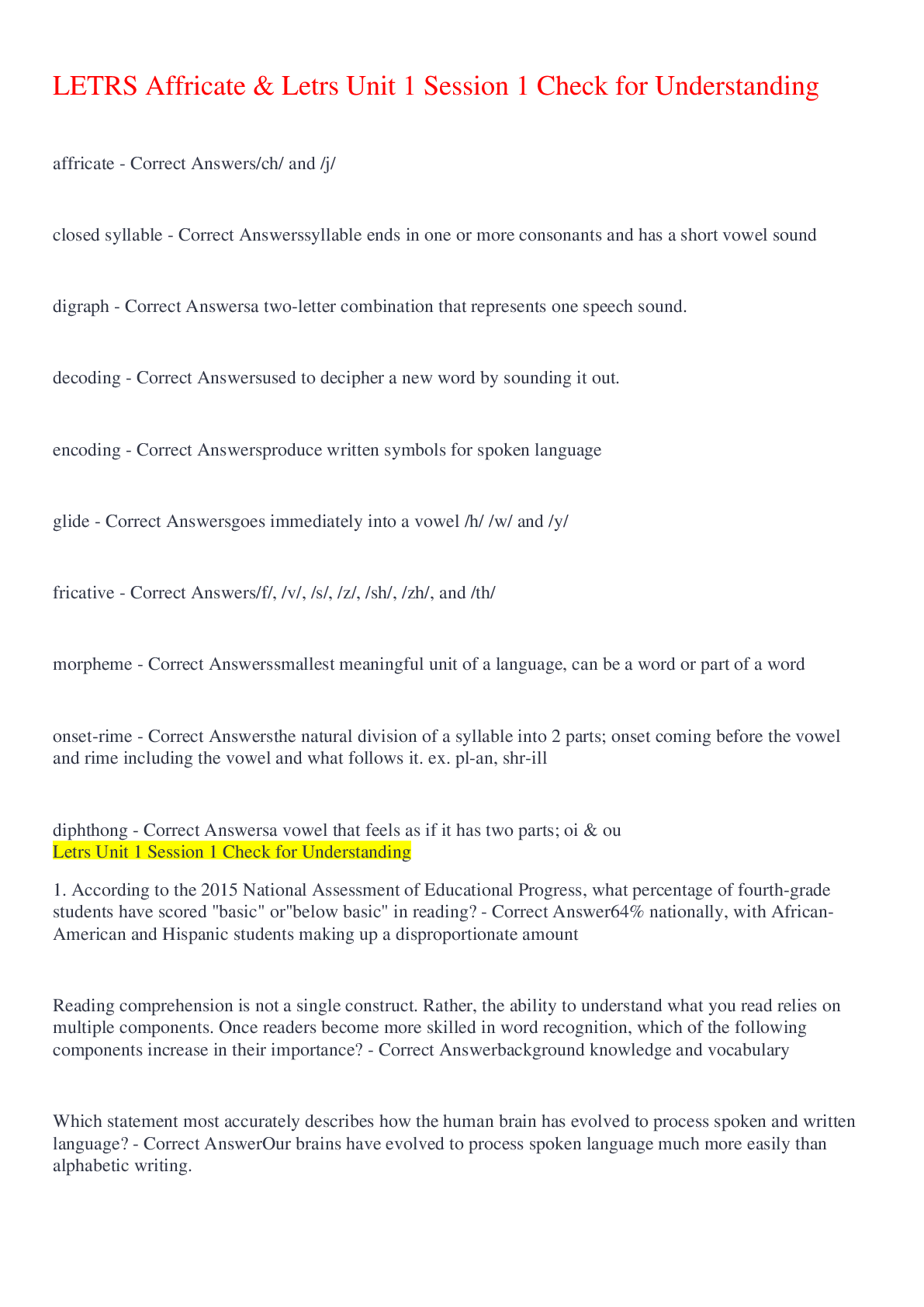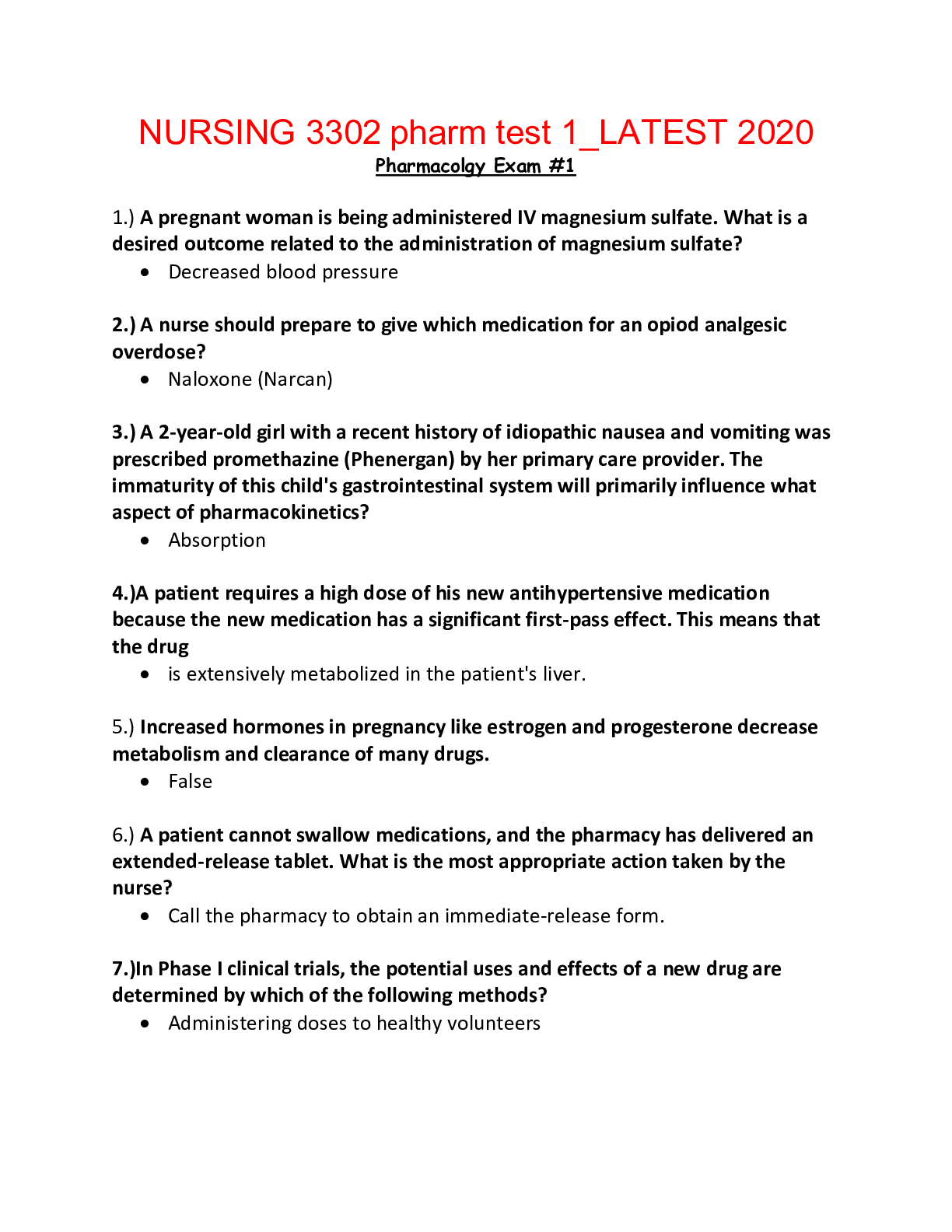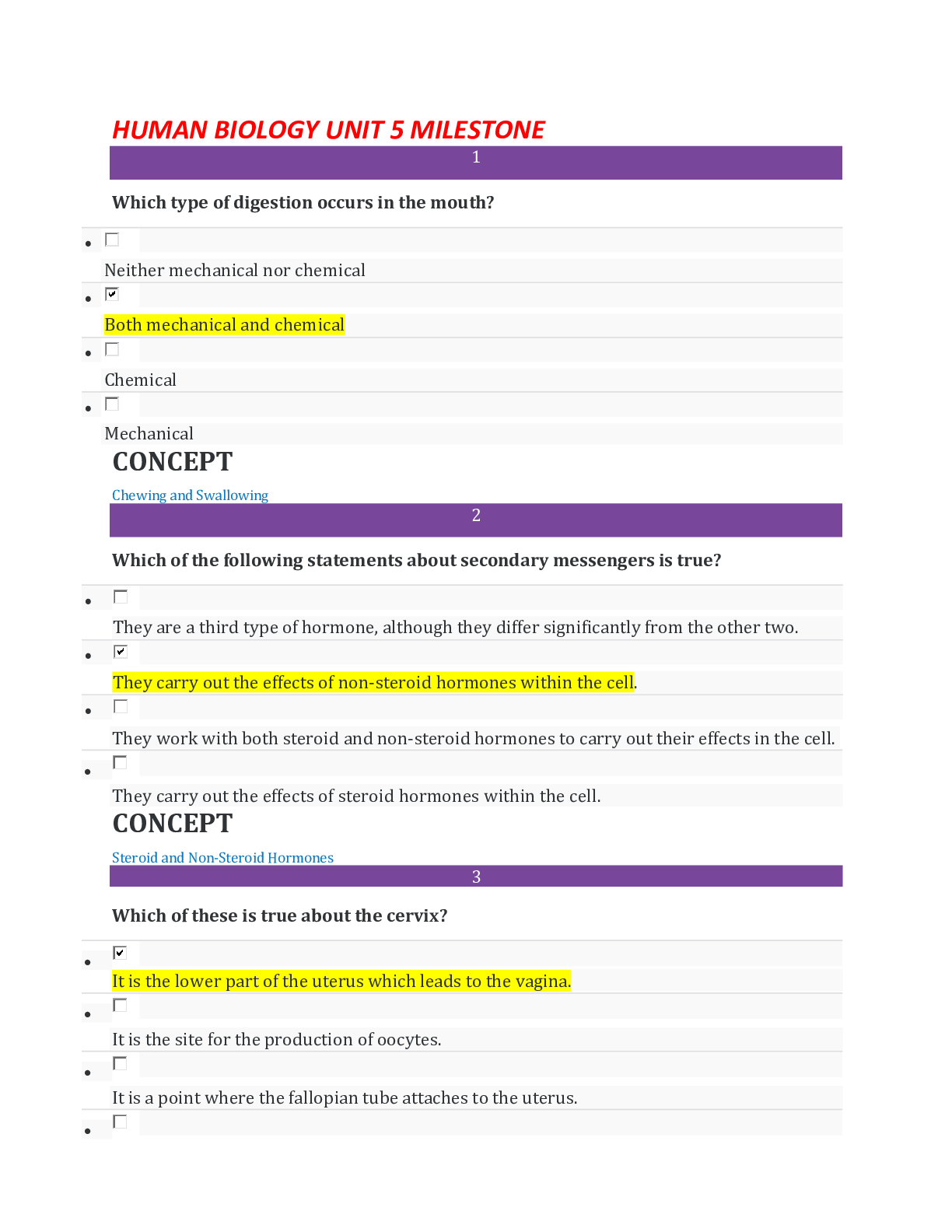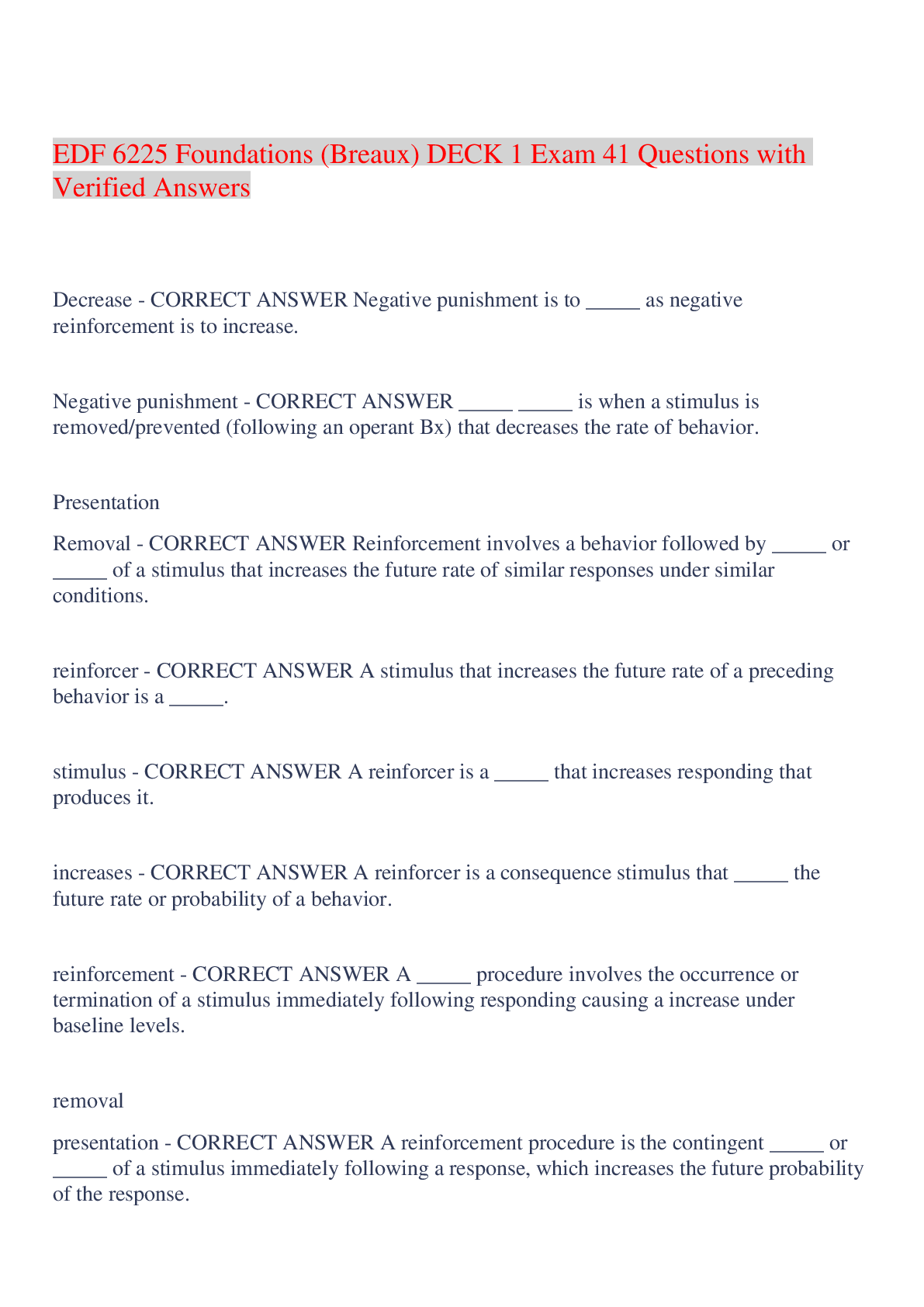AGNP BOARD EXAM QUESTIONSUrology Assessment ( 44 Questions),100% CORRECT
Document Content and Description Below
In renal adaptation of the newborn, which one of the following statements is correct? The kidneys have an inability to concentrate urine and adapt to fluid and electrolyte stress. In the neph... rons of the kidneys long tubules enhance the effectiveness of tubular reabsorption. The kidneys are fully capable of concentrating urine and maintaining fluid and electrolyte balance. The kidneys have the ability to increase the production of antidiuretic hormone (ADH) effectively. Question: What is the most common non-skin cancer in America? Uterine cancer Bladder cancer Cervical cancer Prostate cancer Question: Patients with prior hypospadias surgery who develop slow and painful urination as well as prostatitis are experiencing symptoms of: neurogenic bladder. urethral stricture. benign prostatic hyperplasia (BPH). prostate cancer. Question: What is the average urine pH level? 4.5 6 7 8 Question: Symptoms of proctitis may include all of the following except: left-sided abdominal pain. rectal pain. suprapubic pain. tenesmus. Question: A useful mnemonic for elucidating causes of incontinence in the older adult is: STOOL. DIAPERS. DRIP. URINE. Question: Which of the following symptoms is NOT associated with nephrotic syndrome? Proteinuria Hyperlipidemia Lower leg edema Hyperalbuminosa Question: In afebrile patients who experience intermittent sharp flank pain in addition to gross hematuria, further testing would be indicated for: pelvic inflammatory disease (PID). pyelonephritis. nephrolithiasis. urethritis. . Question: After running a 5K race, a 35-year-old man presents with complaints of muscle pain in the shoulders, weakness in both legs, and dark brown urine. These findings are consistent with: a urinary tract infection (UTI). rhabdomyolysis. acute renal failure. renal calculi. Question: When testing for pyelonephritis, the exam technique of percussing the back over the kidney that produces flank pain is called: Murphy's sign. psoas sign. Pasternacki's sign. Rovsing’s sign. Question: A form of urinary incontinence that is characterized by the involuntary release of urine from a full bladder in the absence of any need to urinate is called: stress incontinence. urge incontinence. overflow incontinence. functional incontinence. Question: One cause of proctitis could be related to: gastritis. frequent anal intercourse. cirrhosis. pancreatitis. Question: An infection or irritation of the bladder that leads to pain on urination is called: polyuria. dysuria. urgency. incontinence. Question: Symptoms of fever, chills, flank pain, costovertebral angle tenderness (CVA), and vomiting suggest: pelvic inflammatory disease (PID). pyelonephritis. nephrolithiasis. urethritis. Question: Which of the following substances is found in the urine of a child suspected of having post streptococcal glomerulonephritis? Blood and protein Bacteria and ketones Glucose and white blood cells Casts and mucous threads Question: A significant increase in 24-hour urine volume that exceeds 3 liters is called: polyuria. dysuria. urgency. frequency. Question: The findings of mucopurulent endocervical discharge and cervical motion tenderness on pelvic examination are strongly suggestive of: pelvic inflammatory disease (PID). pyelonephritis. nephrolithiasis urethritis. Question: In men, painful urination without frequency or urgency suggests: cystitis. urethritis. constipation. acute prostatitis. Question: Which one of the following is NOT a cause of vaginitis? yeast infection. herpes simplex virus. trichomoniasis. bacterial vaginosis (BV). Question: Which one of the following conditions is NOT related to polyuria? lithium toxicity. hyperkalemic nephropathy. uncontrolled diabetes. hypogonadism. Question: The prostate is assessed by: a digital rectal examination (DRE). a formal urinalysis. testicular palpation and cough. palpation of the left lower quadrant. Question: Which one of the following patient positions would be least beneficial to examine the genitals of a young female child? Have the child sit on her parent's lap with the parent holding the child's knees apart Have the child lie supine in the frog-leg position Have the child sit crossed legged on the examination table Position the child in the knee-chest position Question: Benign prostatic hypertrophy begins in the: second decade of life. third decade of life. fourth decade of life. fifth decade of life. Question: Patients with multiple sclerosis (MS) who develop urinary incontinence are further evaluated for: neurogenic bladder. urethral stricture. benign prostatic hyperplasia (BPH). prostatitis. Question: Which condition usually coexists with epididymitis? Varicocele of the spermatic cord Spermatocele of the epididymis Torsion of the spermatic cord Chlamydia infection Question: A 50-year-old male describes difficulty emptying his bladder. On exam, a distended bladder is noted following urination. This finding may be associated with: functional incontinence. overflow incontinence. urge incontinence. stress incontinence. Question: Clinical manifestations of dysuria, frequency, urgency, suprapubic pain, and hematuria in a woman suggest: cystitis. vaginitis. urethritis. nephrolithiasis. Question: Which one of the following symptoms would be least indicative of acute glomerulonephritis? Hematuria Polyuria Proteinuria Hypertension Question: A 65-year-old woman complains that when she feels the urge to urinate, she has to go immediately or else she urinates "on herself". She has become homebound because she wants to stay close to the bathroom. This condition is termed: functional incontinence. overflow incontinence. urge incontinence. stress incontinence. Question: Insufficient strength of the pelvic floor muscles that results in incontinence during activities such as coughing, sneezing, or bearing down, is called: urge incontinence. stress incontinence. overflow incontinence. functional incontinence. Question: A 40 -year-old male states that he felt "something" above his left testis. On examination, a painless cyst is noted above the left testicle. Transillumination is positive. This is consistent with a: varicocele of the spermatic cord. spermatocele of the epididymis. torsion of the spermatic cord. prostatitis. Question: When screening for bladder cancer in a primary care setting, the test that would be LEAST appropriate is: microscopic urinalysis. urine cytology. cystoscopy. dipstick for hematuria. Question: When examining the scrotum in a young male child, test the cremasteric reflex by: scratching the medial aspect of the thigh. having the child lie down and palpate the femoral pulse. gently pulling the penis downward. palpating the area above the symphysis pubis. Question: Findings of myoglobin in the urine specimen suggest: renal colic. nephrolithiasis. pyelonephritis. rhabdomyolysis. Question: Which of the following is described as an involuntary loss of urine occurring for no apparent reason while suddenly feeling the need to urinate? Stress incontinence Urge incontinence Overflow incontinence Functional incontinence Question: A gynecological infection characterized by itching, burning, and a vaginal discharge that is typically cheesy in texture and white in color is: trichomoniasis. bacterial vaginosis (BV). yeast infection. gonorrhea. Question: A 40 year old male complains of right flank pain. His temperature is 102° F. These symptoms may be characteristic of: renal calculi. acute pyelonephritis. urethritis. prostatitis. Question: Chronic bladder pain syndrome (BPS) that causes symptoms of urinary urgency, frequency, and hesitancy is also known as: interstitial cystitis. endometriosis. urinary tract infection. pelvic inflammatory disease. Question: A 66-year-old man presents with complaints of recent nocturia, hesitancy, straining, and a slow urine stream. These symptoms describe: neurogenic bladder. urethral stricture. benign prostatic hyperplasia (BPH). prostate cancer. Question: Undescended testicle(s) in a young male is termed: testicular torsion. epispadias. hydrocele. cryptorchidism. Question: A form of urinary incontinence in which a person is usually aware of the need to urinate, but for one or more physical or mental reasons they are unable to get to a bathroom, is referred to as: stress incontinence. urge incontinence. overflow incontinence. functional incontinence. Question: A whitish sebaceous secretion that collects between the glans penis and foreskin or in the vulva is known as: candida. smegma. leukorrhea. leukocoria. Question: A 33 year old male presents for examination because of a scrotal complaint. The exam reveals the presence of 2 testicles and palpable tissue resembling a "bag of worms" over the left testicle. When in the supine position with the scrotum elevated, the "bag of worms" disappears. This condition is suggestive of a: varicocele of the spermatic cord. spermatocele of the epididymis. torsion of the spermatic cord. prostatitis. Question: Glomerulonephritis can cause: nephrotic syndrome. diabetic nephropathy. polycystic kidney disease. pyelonephritis. [Show More]
Last updated: 2 years ago
Preview 1 out of 20 pages
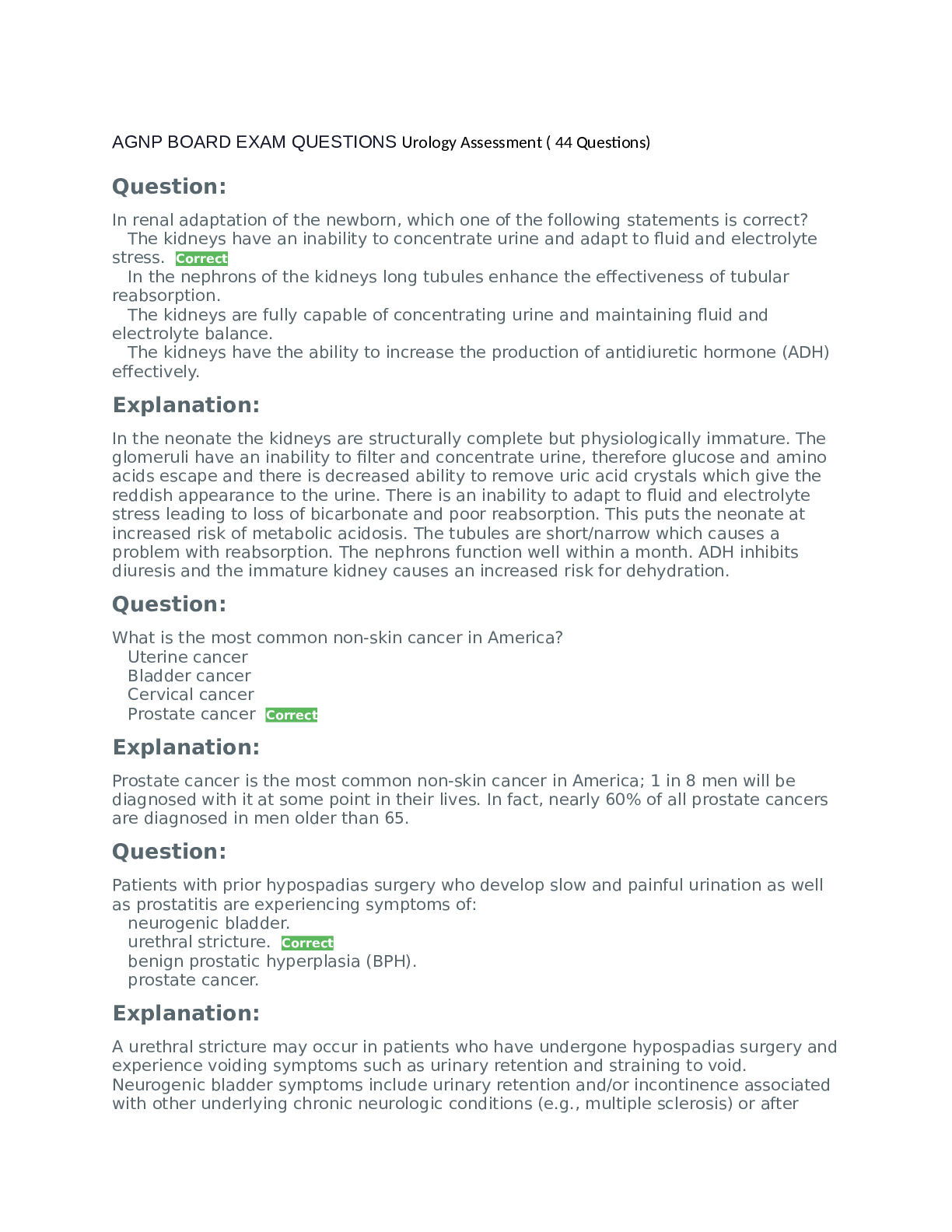
Buy this document to get the full access instantly
Instant Download Access after purchase
Buy NowInstant download
We Accept:

Reviews( 0 )
$16.00
Can't find what you want? Try our AI powered Search
Document information
Connected school, study & course
About the document
Uploaded On
Jan 23, 2021
Number of pages
20
Written in
Additional information
This document has been written for:
Uploaded
Jan 23, 2021
Downloads
0
Views
57


